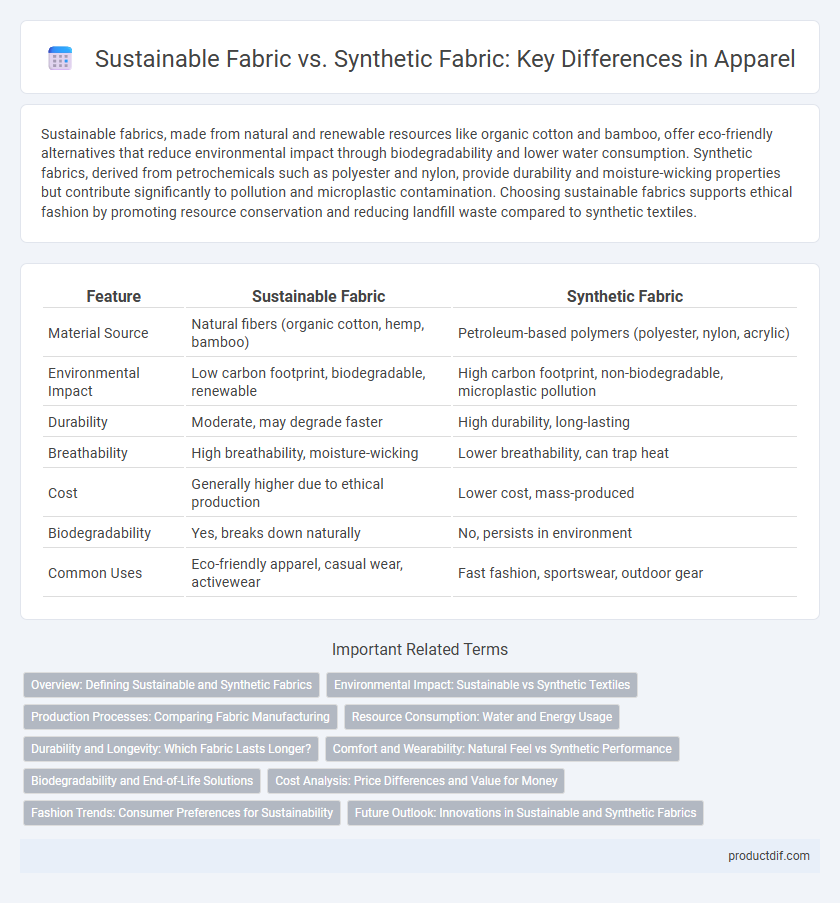Sustainable fabrics, made from natural and renewable resources like organic cotton and bamboo, offer eco-friendly alternatives that reduce environmental impact through biodegradability and lower water consumption. Synthetic fabrics, derived from petrochemicals such as polyester and nylon, provide durability and moisture-wicking properties but contribute significantly to pollution and microplastic contamination. Choosing sustainable fabrics supports ethical fashion by promoting resource conservation and reducing landfill waste compared to synthetic textiles.
Table of Comparison
| Feature | Sustainable Fabric | Synthetic Fabric |
|---|---|---|
| Material Source | Natural fibers (organic cotton, hemp, bamboo) | Petroleum-based polymers (polyester, nylon, acrylic) |
| Environmental Impact | Low carbon footprint, biodegradable, renewable | High carbon footprint, non-biodegradable, microplastic pollution |
| Durability | Moderate, may degrade faster | High durability, long-lasting |
| Breathability | High breathability, moisture-wicking | Lower breathability, can trap heat |
| Cost | Generally higher due to ethical production | Lower cost, mass-produced |
| Biodegradability | Yes, breaks down naturally | No, persists in environment |
| Common Uses | Eco-friendly apparel, casual wear, activewear | Fast fashion, sportswear, outdoor gear |
Overview: Defining Sustainable and Synthetic Fabrics
Sustainable fabrics are derived from renewable resources and produced through eco-friendly processes that minimize environmental impact, often incorporating organic fibers like organic cotton, hemp, or bamboo. Synthetic fabrics, such as polyester, nylon, and acrylic, are petroleum-based materials engineered for durability, moisture resistance, and cost efficiency but typically involve non-biodegradable components and higher carbon emissions. Understanding the distinctions between sustainable and synthetic fabrics is critical for making environmentally responsible choices in apparel manufacturing and consumer purchasing.
Environmental Impact: Sustainable vs Synthetic Textiles
Sustainable fabrics, such as organic cotton, hemp, and bamboo, significantly reduce environmental impact by utilizing renewable resources and biodegrading naturally without leaving toxic residues. Synthetic fabrics like polyester and nylon are derived from petrochemicals, contributing to greenhouse gas emissions and microplastic pollution during washing and disposal. Choosing sustainable textiles supports reduced energy consumption, lower carbon footprints, and minimal ecological damage compared to synthetic alternatives.
Production Processes: Comparing Fabric Manufacturing
Sustainable fabric production relies on eco-friendly raw materials such as organic cotton, hemp, and recycled fibers, utilizing low-impact dyes and water-saving techniques that minimize chemical runoff and energy consumption. In contrast, synthetic fabric manufacturing often involves petrochemical-based polymers like polyester and nylon, produced through energy-intensive processes that release greenhouse gases and microplastics during production and use. The shift toward sustainable fabrics emphasizes closed-loop systems and renewable resources to reduce environmental footprints compared to traditional synthetic fabric supply chains.
Resource Consumption: Water and Energy Usage
Sustainable fabrics such as organic cotton and hemp consume significantly less water compared to synthetic fabrics like polyester, which require extensive water for production and cooling processes. Energy usage in sustainable fabric manufacturing is generally lower due to natural fiber cultivation relying on solar energy, whereas synthetic fabric production depends heavily on fossil fuel-based energy for polymer synthesis. Choosing sustainable fabrics reduces overall resource depletion, promoting environmentally responsible apparel production.
Durability and Longevity: Which Fabric Lasts Longer?
Sustainable fabrics like organic cotton, hemp, and Tencel boast impressive durability due to their natural fiber strength and eco-friendly processing methods that minimize wear and tear. Synthetic fabrics such as polyester and nylon offer high resistance to stretching, shrinking, and abrasions, contributing to their long lifespan in activewear and outdoor apparel. However, sustainable fabrics can often match or exceed synthetic materials in longevity when properly cared for, making them a viable option for eco-conscious consumers seeking durable garments.
Comfort and Wearability: Natural Feel vs Synthetic Performance
Sustainable fabrics like organic cotton and hemp offer superior breathability and softness, providing a natural feel that enhances comfort for prolonged wear. Synthetic fabrics such as polyester and nylon deliver high durability, moisture-wicking properties, and stretchability, optimizing performance in activewear and demanding conditions. Balancing natural comfort with synthetic innovations is key to achieving versatile apparel suited for both everyday use and high-performance activities.
Biodegradability and End-of-Life Solutions
Sustainable fabrics such as organic cotton, hemp, and Tencel offer superior biodegradability, breaking down naturally within months to years, compared to synthetic fabrics like polyester and nylon that can persist in landfills for centuries. End-of-life solutions for sustainable fabrics include composting and recycling, promoting a circular economy in the apparel industry. In contrast, synthetic fabrics often require energy-intensive recycling processes and contribute to microplastic pollution, challenging environmental sustainability goals.
Cost Analysis: Price Differences and Value for Money
Sustainable fabrics such as organic cotton and bamboo generally have higher upfront costs compared to synthetic fabrics like polyester and nylon, primarily due to eco-friendly farming and processing methods. Despite the higher price, sustainable fabrics offer greater long-term value through biodegradability, better durability, and reduced environmental impact, which appeals to eco-conscious consumers. Synthetic fabrics are typically cheaper and widely available, but their reliance on petrochemicals and limited recyclability often result in hidden environmental and disposal costs, affecting overall value for money.
Fashion Trends: Consumer Preferences for Sustainability
Sustainable fabrics such as organic cotton, hemp, and bamboo are increasingly favored in fashion trends due to their reduced environmental impact and biodegradability compared to synthetic fabrics like polyester and nylon. Consumers prioritize sustainable fabric choices that support eco-friendly production methods, water conservation, and lower carbon footprints, driving demand for transparency in supply chains. Innovations in recycled materials and biodegradable textiles continue to shift market preferences towards sustainable fashion, influencing global apparel brands to adopt greener practices.
Future Outlook: Innovations in Sustainable and Synthetic Fabrics
Innovations in sustainable fabrics focus on biodegradable fibers, bio-based materials, and advanced recycling technologies to reduce environmental impact and promote circular fashion. Synthetic fabrics are evolving with the development of bio-derived polymers and enhanced durability, improving performance while addressing ecological concerns. The future outlook reveals a convergence of sustainability and technology, driving apparel industry transformation towards eco-friendly and high-performance textiles.
Sustainable Fabric vs Synthetic Fabric Infographic

 productdif.com
productdif.com